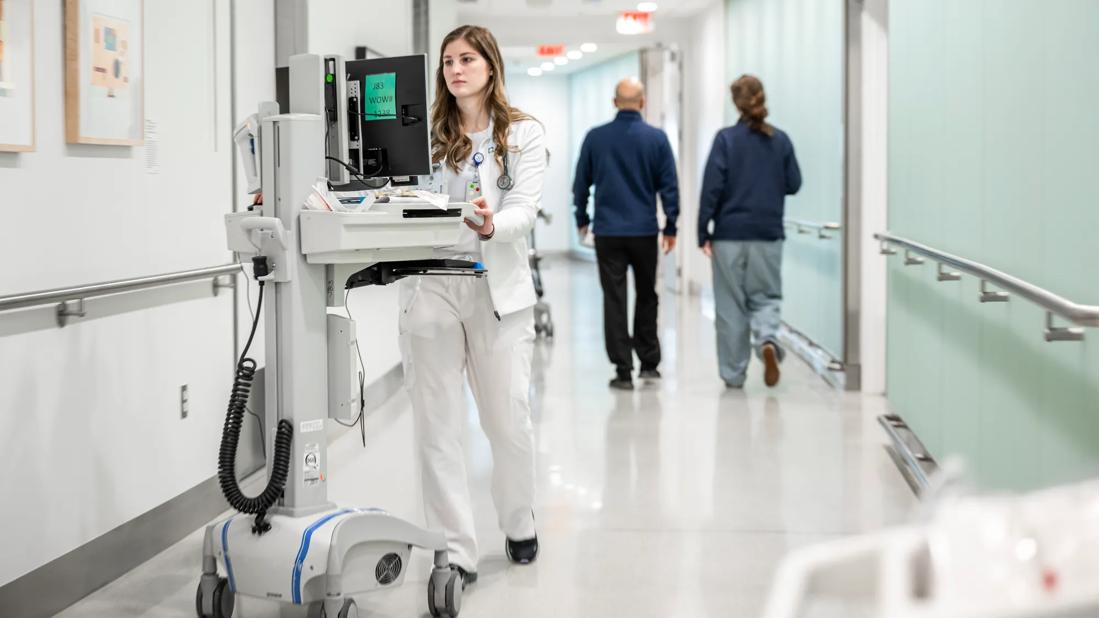New center improves patient transports, garners national attention

When a patient is ready to be discharged to a rehabilitation hospital or skilled nursing facility, it’s in everybody’s interest for that transfer to happen quickly. Too often, however, patients wait in limbo while the sending and receiving facilities work through the logistical challenges that can encumber transportation.
Advertisement
Cleveland Clinic is a non-profit academic medical center. Advertising on our site helps support our mission. We do not endorse non-Cleveland Clinic products or services. Policy
Determined to accelerate and simplify patient transfers, Cleveland Clinic has established a Care Management Resource Center (CMRC) that is dedicated to managing and improving the process.
Linda O’Donnell, senior director for Care Management Operations, says the CMRC has significantly reduced wait times by redistributing certain clerical tasks, streamlining the precertification process with payers and facilities, and building relationships with patients’ families. Cleveland Clinic’s revised approach has been so successful, it is being adopted by other medical centers around the country.
“Taking the initiative to fine-tune the transfer process was a great opportunity for us,” says O’Donnell. “It helps us put patients first by ensuring that we’re quickly and seamlessly getting them the level of care they need.”
The CMRC originated in 2018 with a 90-day pilot project on Cleveland Clinic’s main campus. Since its inception, the program has reduced transfer times by nearly one business day, with an average turnaround time of 23 to 25 hours, says O’Donnell.
“It’s rare to see a procedural shift result in such rapid improvements,” she explains. “We’re encouraged by how much the new program has boosted the efficacy of our transfer process, of course, but we’re especially heartened by how significantly the CMRC has benefited patients.”
When analyzing their former transfer process, the CMRC team quickly realized that many of the postponements encountered during patient discharge stemmed from hiccups in the precertification process. Paperwork delays and problems communicating with a wide variety of payers contributed to the problem, says O’Donnell. In some cases, receiving facilities would agree to take the patient – but with an unpredictable caveat: They’d need to wait an undetermined number of hours, or even days, for a bed to become free.
Advertisement
Compounding matters, most transfers were handled by the patient’s care providers, who didn’t always have time to follow up frequently enough to keep the process moving.
“We want our caregivers to be working at the top of their license, so it didn’t make sense to have a registered nurse doing paperwork,” explains Laurel Yee, manager of the CMRC. “Documentation is now handed off to a care manager, who works with the patient’s family to find an appropriate receiving facility.”
Once precertification is underway, the care manager keeps the process moving by coordinating with receiving facilities. If the receiving hospital doesn’t act within a few hours to accept the patient and complete approvals, the team will quickly move on to the next suitable facility on the list.
“There are a number of elements that must be coordinated in a very short period of time, so the more barriers we can remove, the faster we can get our patients where they need to be,” O’Donnell says.
In addition to streamlining the transfer process, having a dedicated care management team has led to better communication and closer relationships with partner facilities and insurance providers, Yee notes.
“The new process has opened up bidirectional conversations that didn’t exist before,” she says. “The insurance providers now know that they are being held accountable for the turnaround times described in their contracts.”
In addition, the streamlined transfer process has made it easier to spot problems and coordinate solutions before they escalate, notes Yee. For example, when the team identified a transportation issue – a backlog of ambulances in the late afternoon, when multiple patients were being transferred at approximately the same time – Cleveland Clinic contracted with an ambulance company to secure additional vehicles and improve scheduling.
Advertisement
Another solution was to create a Microsoft Teams channel that allows team members to communicate in real time, explains Yee. “If one patient isn’t going to be ready at a certain time, the care manager can relay that information to the transport folks. This allows them to quickly reschedule the transfer and – in some cases – expedite the transport of another waiting patient,” she says.
The CMRC’s launch has inspired other medical centers to adopt the innovative model, says O’Donnell, whose team presented the program at the annual conference of the Case Management Society of America in 2022.
Yee emphasizes that improving the patient transfer process not only improves efficiency and safeguards clinical resources, but it also enhances patient satisfaction, safety and care. “There is no substitute for receiving the right level of care at the right time,” she says. “A well-orchestrated transfer process can make a pivotal difference in the health and wellbeing of our patients.”
Advertisement
Advertisement

How to create a welcoming environment and provide high-quality care for patients who are neurodivergent

Music therapists provide solace, help patients meet therapeutic goals

E-learning modules improve learning, satisfaction and more

Remote caregivers allow bedside nurses to breathe easier when out of a patient’s room

CNO offers advice for listening to patients, interacting with families and communicating effectively

Prototype leverages collaboration between nurses and nursing assistants

Nurses play key role in comprehensive lifetime treatment program

Compassionate care requires nurses to see beyond medical conditions to understand the complete patient